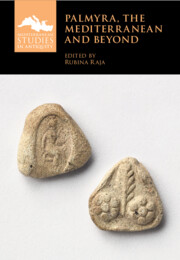Refine search
Actions for selected content:
18 results

Palmyra, the Mediterranean and Beyond
-
- Published online:
- 21 October 2025
- Print publication:
- 16 October 2025
2 - The Western Networks of Palmyra
-
-
- Book:
- Palmyra, the Mediterranean and Beyond
- Published online:
- 21 October 2025
- Print publication:
- 16 October 2025, pp 21-32
-
- Chapter
- Export citation
1 - Palmyra in the Mediterranean World
-
-
- Book:
- Palmyra, the Mediterranean and Beyond
- Published online:
- 21 October 2025
- Print publication:
- 16 October 2025, pp 1-20
-
- Chapter
- Export citation
4 - Palmyrene Iconographic Traditions and Their Mediterranean Connections
-
-
- Book:
- Palmyra, the Mediterranean and Beyond
- Published online:
- 21 October 2025
- Print publication:
- 16 October 2025, pp 49-109
-
- Chapter
- Export citation
5 - Palmyra and Emesa or ‘Palmyre sans Émèse’
-
-
- Book:
- Palmyra, the Mediterranean and Beyond
- Published online:
- 21 October 2025
- Print publication:
- 16 October 2025, pp 110-126
-
- Chapter
- Export citation
9 - Encrusted in Ancestors
-
-
- Book:
- Relief in Greek, Roman, and Late Antique Art
- Published online:
- 11 October 2025
- Print publication:
- 25 September 2025, pp 288-320
-
- Chapter
- Export citation
44 - Peoples of Syria
- from Part IV - Regional and Ethnic Variety
-
- Book:
- The Cambridge Encyclopaedia of Late Antique Art and Archaeology
- Published online:
- 04 July 2025
- Print publication:
- 31 July 2025, pp 777-791
-
- Chapter
- Export citation
Chapter 20 - Empire
- from Part II - Intellectual, Cultural, and Political Contexts
-
-
- Book:
- Percy Shelley in Context
- Published online:
- 17 April 2025
- Print publication:
- 24 April 2025, pp 150-157
-
- Chapter
- Export citation
Part III - “Kindred with the Mummy”
-
- Book:
- Temporal Forms and the Nineteenth-Century Mediterranean
- Published online:
- 09 November 2024
- Print publication:
- 14 November 2024, pp 161-225
-
- Chapter
- Export citation
Chapter 5 - Lord of the Universe, the World and Eternity
-
-
- Book:
- The Names of the Gods in Ancient Mediterranean Religions
- Published online:
- 23 February 2024
- Print publication:
- 07 March 2024, pp 95-110
-
- Chapter
- Export citation
1 - Dura-Europos and The Roman Garrison
-
- Book:
- Latin Military Papyri of Dura-Europos (<i>P.Dura</i> 55–145)
- Published online:
- 21 July 2023
- Print publication:
- 10 August 2023, pp 1-21
-
- Chapter
- Export citation
11 - First Parthian Conquest, 141 BC, to the Visit of Trajan in AD 116
-
- Book:
- The City of Babylon
- Published online:
- 23 June 2021
- Print publication:
- 08 July 2021, pp 308-318
-
- Chapter
- Export citation
10 - Darius I to Alexander, and Seleucid to Parthian Rule
-
- Book:
- The City of Babylon
- Published online:
- 23 June 2021
- Print publication:
- 08 July 2021, pp 275-307
-
- Chapter
- Export citation
Archaeological heritage in the age of digital colonialism
-
- Journal:
- Archaeological Dialogues / Volume 27 / Issue 2 / December 2020
- Published online by Cambridge University Press:
- 13 November 2020, pp. 113-125
-
- Article
-
- You have access
- Open access
- HTML
- Export citation
Compilation and digitisation of the Palmyrene corpus of funerary portraits
-
- Article
-
- You have access
- HTML
- Export citation
Weaponizing monuments
-
- Journal:
- International Review of the Red Cross / Volume 99 / Issue 906 / December 2017
- Published online by Cambridge University Press:
- 07 February 2019, pp. 937-957
- Print publication:
- December 2017
-
- Article
-
- You have access
- HTML
- Export citation
16 - The Arabs and the desert peoples
- from PART V - THE NON-ROMAN WORLD
-
-
- Book:
- The Cambridge Ancient History
- Published online:
- 28 March 2008
- Print publication:
- 08 September 2005, pp 498-520
-
- Chapter
- Export citation
